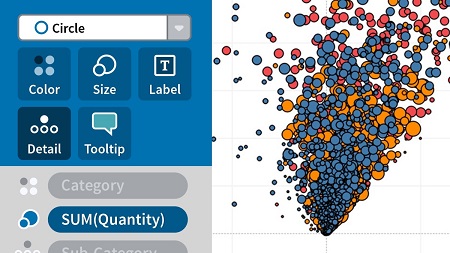
English | MP4 | AVC 1280×720 | AAC 44KHz 2ch | 5h 55m | 1.34 GB
If your work requires any sort of graphical visualization of data, chances are you’ve run into Tableau. If you’ve been using Tableau but want to learn how to really harness its full power for data science, join expert Matt Francis in this course as he shows you how to take your skills to the next level. Matt starts with one of the most important features in Tableau: the difference between the green and blue pills (discrete and continuous data) and how this affects every single action Tableau performs. He then shows how to connect to and combine data from different data sources, how to create different charts to make sense of data, ways to transform your data with calculations, and how to create interactive maps. Finally, Matt details ways to present data effectively and how to make engaging dashboards. Whether you want to learn more about Tableau as a whole, or if you just want to improve your knowledge of a single subject, this course will help up your Tableau game.
Table of Contents
Introduction
1 The power of Tableau for data scientists
2 What you should know
1. Green and Blue Fields What Do They Mean
3 Understand the difference between green and blue fields
4 How do green and blue fields affect rows and columns
5 How do green and blue fields affect colors
6 How do green and blue fields affect filters
7 How do green and blue fields affect dates
8 Challenge Green and blue
9 Solution Green and blue
2. Connecting to a Source of Data
10 How to connect to Excel sheets
11 How to clean Excel data with the data interpreter
12 How to connect to PDF files and extract tables of data
13 How to connect to a local database
14 Challenge Connecting to data
15 Solution Connecting to data
3. Combining Data
16 Combining data using relationships
17 What are the different ways of joining data
18 How to join tables in the same data connection
19 How to join tables using a cross-database join
20 How to append one data source to another using unions
21 Challenge Combining data
22 Solution Combining data
4. When and How to Create Data Extracts
23 What are the pros and cons of using a data extract
24 How to create a data extract
25 How to limit the data in a data extract
26 How to edit a data extract to include more data
27 Challenge Working with extracts
28 Solution Working with extracts
5. Comparing Measures
29 Solution Comparing measures
30 What are measure names and measure values
31 Creating a combined axis chart
32 Creating a dual axis chart
33 Creating a bar in bar chart
34 Creating a multiple measure crosstab
35 Enhance a crosstab using colors to create a highlight table
36 Comparing two measures using a scatter plot
37 Enhance scatter plots using trend lines and animation
38 Challenge Comparing measures
6. Transform Your Data with Calculations
39 How do calculations work in Tableau
40 Using calculations in a join
41 How do table calculations work
42 What are level of detail (LOD) calculations
43 Convert strings to dates and dates to strings
44 Calculate time durations
45 Using IF calculations
46 Challenge Calculations
47 Solution Calculations
7. Mapping Your Data
48 Just because you can, should you create a map
49 How to create an area map
50 How to create a symbol map
51 Customizing the look of your maps
52 Create locations from coordinates
53 Create lines to connect locations on a map
54 Analyzing distances using buffer calculations
55 Challenge Mapping
56 Solution Mapping
8. Analytics
57 Using colors to highlight data
58 How to create reference lines
59 How to create reference bands
60 How to use motion to show changes over time
61 Challenge Analytics
62 Solution Analytics
9. Using Parameters for Greater Interaction
63 How are parameters different from filters
64 How to use parameters in calculations
65 Create dynamic reference lines using parameters
66 Use a parameter to select dimensions and measures
67 Use a parameter to search free text fields
68 Top N analysis
69 Challenge Parameters
70 Solution Parameters
10. Dashboard Actions and Design Tips
71 Solution Dashboards
72 How to use containers in a dashboard
73 How to create a tiled dashboard
74 How to create a floating dashboard
75 How to create device-specific dashboards
76 How to use filter actions
77 How to use highlight actions
78 How to use URL actions
79 How to use set actions
80 Challenge Dashboards
11. Conclusion
81 How can I grow my data science and Tableau skills
Resolve the captcha to access the links!